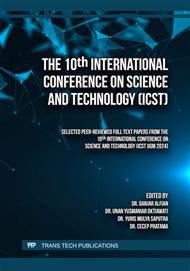[1]
Basavaiah, Geomagnetism: Solid earth and upper atmosphere perspectives, Indian Institute of Geomagnetism Navi Mumbai, India, 2011.
Google Scholar
[2]
A.J. Zmuda, J.H. Martin, F.T. Heuring, Transverse magnetic disturbances at 1100 km in the auroral region, Journal of Geophysical Research. 71 (1966) 5033-5045.
DOI: 10.1029/jz071i021p05033
Google Scholar
[3]
R.Shahzad, M. Shah, M.A. Tariq, A. Calabia, A. M-Morales, P. Jamjareegulgarn, L. Liu, Ionospheric–thermospheric responses to geomagnetic storms from multi-instrument space weather data, Remote Sensing. 15 (2023) 2687.
DOI: 10.3390/rs15102687
Google Scholar
[4]
S. Taguchi, K. Hosokawa, Y. Ogawa, Investigating the particle precipitation of a moving cusp aurora using simultaneous observations from the ground and space, Progress in Earth and Planetary Science. 2 (2015).
DOI: 10.1186/s40645-015-0044-7
Google Scholar
[5]
K.Ya. Kondrate'ev (Ed.), Radiation characteristics of the atmosphere and the earth's surface, Amerind Publishing Co. Pvt. Ltd., New Delhi, 1973.
Google Scholar
[6]
N. Jacowski, Y. Béniguel, G.D. Franceschi, M.H. Pajares, K.S. Jacobsen, I. Stanislawska, L. Tomasik, R. Wamant, G. Wautelet, Monitoring, tracking and forecasting ionospheric perturbations using GNSS techniques, Journal of Space Weather and Space Climate. 2 (2012) A22.
DOI: 10.1051/swsc/2012022
Google Scholar
[7]
Asnawi, Statistical analysis of ionospheric scintillation occurrences in the low-latitude region of Indonesia based on observational data from the Kotatabang station, Journal of Aerospace Science and Technology. 8 (2015).
Google Scholar
[8]
Y.J. Morton, Z. Yang, B. Breitsch, H. Bourne, C. Rino, Ionospheric effects, monitoring, and mitigation techniques, Position, Navigation, and Timing Technologies in the 21st Century: Integrated Satellite Navigation, Sensor Systems, and Civil Applications. 1 (2020).
DOI: 10.1002/9781119458449.ch31
Google Scholar
[9]
L. Spogli, C. Cesaroni, D. Di Mauro, M. Pezzopane, L. Alfonsi, E. Musicò, G. Povero, M. Pini, F. Dovis, R. Romero, N. Linty, P. Abadi, F. Nuraeni, A. Husin, M.L. Huy, T.T. Lan, T.V. La, V.G. Pillat, N. Floury, Formation of ionospheric irregularities over Southeast Asia during the 2015 st. patrick's day storm, Journal of Geophysical Research: Space Physics. 121 (2016) 12,211-12,233.
DOI: 10.1002/2016ja023222
Google Scholar
[10]
A.Y. Putra, P. Abadi, L.O.M.M. Kilowasid, N. Syafitri, F. Nuraeni, V. Wellyanita, K. Wisnu, C. Purnomo, Suwarno, A. Rakhman, Investigation of geomagnetic storm effects on ionosphere over Pontianak: A study case, In Proceedings of the International Conference on Radioscience, Equatorial Atmospheric Science and Environment and Humanosphere Science, Indonesia. 305 (2023) 567-575.
DOI: 10.1007/978-981-97-0740-9_51
Google Scholar
[11]
P. Abadi, U.A. Ahmad, Y. Otsuka, P. Jamjareegulgarn, D.R. Martiningrum, A. Faturahman, S. Perwitasari, R.E. Saputra, R.R. Septiawan, Modeling post-sunset equatorial spread-f occurrence as a function of evening upward plasma drift using logistic regression, deduced from ionosondes in Southeast Asia, Remote Sensing. 14 (2022) 1896.
DOI: 10.3390/rs14081896
Google Scholar
[12]
C.A. Loewe, G.W. Prolss, Classification and mean behavior of magnetic storms, Journal of Geophysical Research. 102 (1997) 14209-14213.
DOI: 10.1029/96ja04020
Google Scholar
[13]
C.S. Carrano, K.M. Groves, C.L. Rino, On the relationship between the rate of change of total electron content index (ROTI), irregularity strength (CkL), and the scintillation index (S4), Journal of Geophysical Research: Space Physics. 124 (2019) 2099–2112.
DOI: 10.1029/2018ja026353
Google Scholar
[14]
S. Dubey, R. Wahi, A.K. Gwal. Ionospheric effects on GPS positioning, Advances in Space Research. 38 (2006) 2478-2484.
DOI: 10.1016/j.asr.2005.07.030
Google Scholar
[15]
N. Butcher, Daily ionospheric forecasting service (DIFS) III, Annales Geophysicae. 23 (2005) 3591–3598.
DOI: 10.5194/angeo-23-3591-2005
Google Scholar
[16]
C.S. Carmo, C.M. Denardini, C.A.O.B. Figueiredo, L.C.A. Resende, G.A.S. Picanço, P.F. Barbosa Neto, P.A.B. Nogueira, J. Moro, S.S. Chen, Evaluation of different methods for calculating the ROTI index over the brazilian sector, Journal of Advancing Earth and Space Science. 56 (2021) e2020RS007140.
DOI: 10.1029/2020rs007140
Google Scholar
[17]
A. Tahir, F. Wu, M. Shah, C. Amory-Mazaudier, P. Jamjareegulgarn, T.G.W. Verhulst, M.A. Ameen, Multi-instrument observation of the ionospheric irregularities and disturbances during the 23–24 march 2023 geomagnetic storm, Remote Sensing. 16 (2024) 1594.
DOI: 10.3390/rs16091594
Google Scholar
[18]
M. Chakraborty, S. Kumar, B. Kumar De, A. Guha, Effects of geomagnetic storm on low latitude ionospheric total electron content: A case study from Indian sector, Journal of Earth System Science. 124 (2015) 1115–1126.
DOI: 10.1007/s12040-015-0588-3
Google Scholar
[19]
Y. Yamazaki, A. Maute, Sq and EEJ—A review on the daily variation of the geomagnetic field caused by ionospheric dynamo currents, Space Science Reviews. 206 (2017) 299–405.
DOI: 10.1007/s11214-016-0282-z
Google Scholar
[20]
G.K. Parks, Physics of space llasmas: An introduction, Westview Press; 2nd edition, 2003.
Google Scholar


